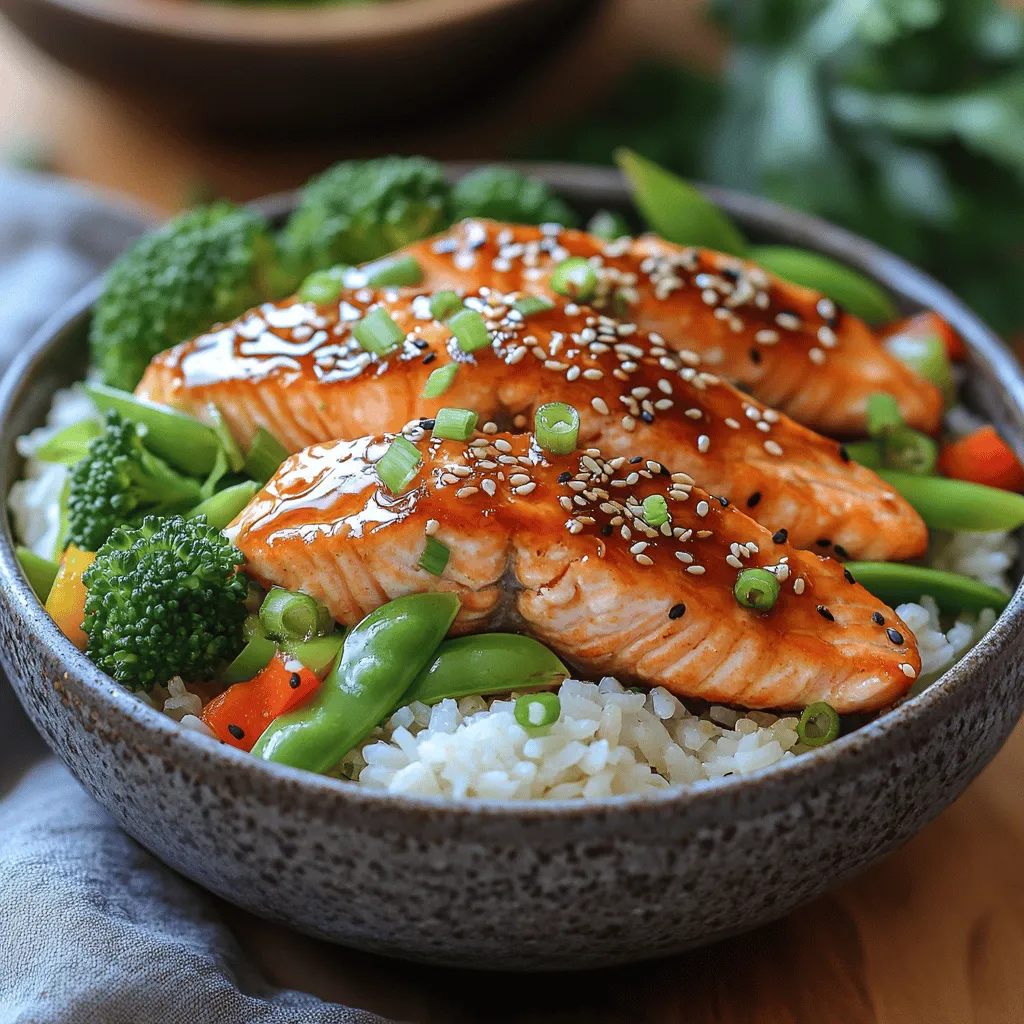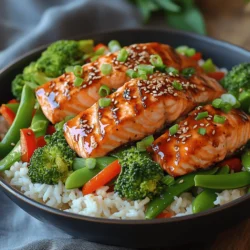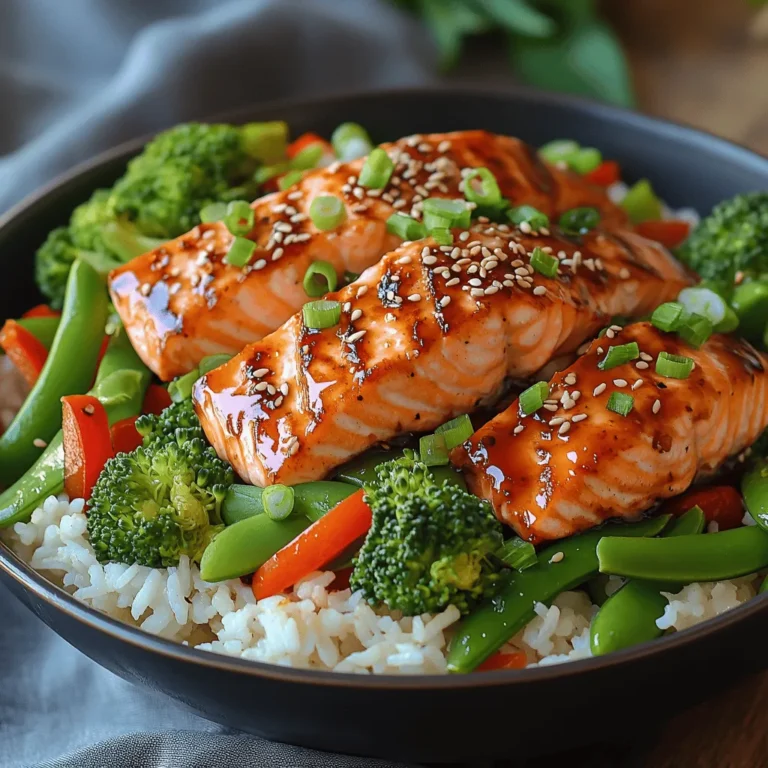Introduction
The One-Pan Teriyaki Salmon & Veggie Rice Bowl is a delightful fusion of flavors that combines tender salmon with vibrant vegetables and fragrant rice. This dish is not only a feast for the senses but also a nutritional powerhouse, making it an ideal meal for health-conscious individuals and families alike. The balance of savory teriyaki sauce, fresh produce, and wholesome grains creates a satisfying dining experience that appeals to a variety of palates.
In today’s fast-paced world, convenience is key, and this one-pan recipe is designed to simplify your cooking routine. With minimal cleanup and quick preparation, you can have a wholesome meal on the table in no time, perfect for busy weeknights or leisurely weekends. The ease of preparation does not compromise flavor or nutrition, making this dish a favorite among home cooks.
Teriyaki flavors have gained immense popularity in Asian cuisine, characterized by their sweet and savory profile. The rich blend of soy sauce, mirin, and sugar in teriyaki adds depth to the dish while offering several health benefits, particularly when combined with the nutritional benefits of salmon and assorted vegetables.
The Allure of Teriyaki Salmon
The origins of teriyaki sauce can be traced back to Japan, where “teriyaki” refers to a cooking technique that involves grilling or broiling food while it’s glazed with a sweet soy sauce mixture. The sauce typically consists of soy sauce, sake or mirin, and sugar, creating a sticky, glossy coating that enhances the flavor of grilled meats and fish. Its unique taste has made it a staple not just in Japanese cuisine but also in various Asian dishes worldwide.
When it comes to the protein in this recipe, salmon stands out as a nutritional gem. Rich in omega-3 fatty acids, salmon is known for its heart-healthy benefits, including reducing inflammation and promoting brain health. Additionally, it is an excellent source of high-quality protein, making it a staple in many health-focused diets. The combination of teriyaki sauce and salmon not only tantalizes the taste buds but also provides a nourishing meal that supports overall well-being.
The inclusion of colorful vegetables in this dish further enhances its nutritional profile. Seasonal vegetables, such as bell peppers, broccoli, and snap peas, add a crunch and freshness that complements the salmon beautifully. These vegetables are packed with essential vitamins, minerals, and antioxidants, contributing to a well-rounded meal that fuels the body and satisfies the palate.
Ingredients Breakdown
To prepare the One-Pan Teriyaki Salmon & Veggie Rice Bowl, you’ll need a selection of fresh ingredients that come together to create a harmonious dish.
Salmon and Marinade Ingredients
– Fresh Salmon Fillets: Choose skin-on fillets for added flavor and moisture during cooking.
– Soy Sauce: A key component of the teriyaki marinade, soy sauce provides a rich umami flavor.
– Mirin: This sweet rice wine adds a subtle sweetness and depth to the marinade.
– Brown Sugar: To enhance the sweetness of the teriyaki sauce and create a caramelized outer layer on the salmon.
– Fresh Ginger: Adds a warm, spicy note that complements the other flavors.
– Garlic: Provides a robust flavor that elevates the entire dish.
The significance of using fresh ginger and garlic cannot be overstated. These ingredients not only enhance the flavor profile but also offer numerous health benefits, including anti-inflammatory and antioxidant properties.
Vegetable and Rice Components
– Jasmine Rice: A fragrant rice that cooks up fluffy and complements the teriyaki flavors perfectly.
– Bell Peppers: Their sweetness and crunch add a vibrant color and texture to the dish.
– Broccoli: Rich in vitamins K and C, broccoli is a nutritious addition that pairs well with the salmon.
– Snap Peas: These tender, crisp vegetables provide a fresh bite and are loaded with nutrients.
Opting for seasonal vegetables not only supports local agriculture but also ensures that your dish is bursting with flavor and freshness.
Step-by-Step Cooking Instructions
Marinating the Salmon
The first step in creating the perfect One-Pan Teriyaki Salmon & Veggie Rice Bowl is marinating the salmon. Marinating is crucial as it allows the flavors to penetrate the fish, resulting in a dish that is both flavorful and aromatic.
1. Prepare the Marinade: In a small bowl, combine soy sauce, mirin, brown sugar, minced ginger, and minced garlic. Whisk until the sugar is dissolved and the ingredients are well incorporated.
2. Marinate the Salmon: Place the salmon fillets in a shallow dish and pour the marinade over them. Ensure the salmon is evenly coated. For optimal flavor infusion, cover and refrigerate for at least 30 minutes, though marinating for a couple of hours or overnight will yield even better results.
3. Achieving the Perfect Marinade Consistency: The marinade should be thick enough to coat the salmon without being overly runny. If you prefer a thicker glaze, consider adding a teaspoon of cornstarch to the marinade before marinating the fish.
Cooking the Rice
While the salmon marinates, you can prepare the jasmine rice, which serves as the base of the dish.
1. Rinse the Rice: Begin by rinsing the jasmine rice under cold water. This process removes excess starch, preventing the rice from becoming gummy and ensuring a light, fluffy texture.
2. Cooking Method: In a medium saucepan, combine the rinsed rice with water (typically a 1:1.5 ratio of rice to water) and a pinch of salt. Bring to a boil over medium-high heat.
3. Simmer Until Done: Once boiling, reduce the heat to low, cover, and let it simmer for about 15 minutes or until the water is absorbed and the rice is tender. Remove from heat and let it sit covered for an additional 5 minutes to finish steaming.
Sautéing the Vegetables
With the salmon marinating and the rice cooking, it’s time to sauté the vegetables.
1. Prepare the Vegetables: While the rice is cooking, wash and chop the bell peppers, broccoli, and snap peas into bite-sized pieces. This will ensure even cooking and a pleasing presentation.
2. Heat the Pan: In a large skillet or sauté pan, heat a tablespoon of oil over medium heat. Once hot, add the vegetables.
3. Sauté: Cook the vegetables for about 5-7 minutes, or until they are tender-crisp. Stir occasionally to ensure they cook evenly and soak up any residual flavors from the pan.
This preparation lays the groundwork for a delicious One-Pan Teriyaki Salmon & Veggie Rice Bowl. The next steps will involve combining these elements for a stunning and flavorful presentation that showcases the best of teriyaki cuisine. Stay tuned for the continuation of this recipe, where we will bring everything together for a complete meal.

Importance of Timing to Maintain the Crispness of Vegetables
When preparing a One-Pan Teriyaki Salmon & Veggie Rice Bowl, timing is everything. To ensure your vegetables maintain their delightful crunch, it’s crucial to consider when to add them to the cooking process. Vegetables like bell peppers, snap peas, and broccoli should be added to the pan after the rice has begun to soften but before it’s fully cooked. This timing allows them to cook through while retaining their vibrant color and crisp texture. Overcooking vegetables not only diminishes their nutritional value but also leads to a less appealing dish.
Suggestions on Vegetable Substitutions for Seasonal Variations
One of the best aspects of a rice bowl is its versatility. Depending on the season, you can easily swap out vegetables to keep the dish fresh and exciting. In spring, consider adding asparagus or peas for a light touch. Summer is perfect for zucchini and cherry tomatoes, while fall can bring in hearty vegetables like butternut squash or Brussels sprouts. Winter may call for root vegetables such as carrots and parsnips. Feel free to mix and match based on what’s available or what you enjoy most!
Cooking the Salmon
Techniques for Achieving the Ideal Sear on Salmon
To achieve a perfectly seared salmon, start with a well-preheated pan. Use medium-high heat and ensure that the oil is shimmering before adding the fillets. For best results, place the salmon skin-side down first; this creates a crispy texture that contrasts beautifully with the tender flesh. Avoid overcrowding the pan, as this can lower the temperature and lead to steaming rather than searing. Let the salmon cook undisturbed for several minutes before flipping to ensure a nice crust forms.
Tips on Checking for Doneness Without Compromising Texture
To check if your salmon is done without compromising its texture, use a fork to gently flake the thickest part of the fillet. If it flakes easily and is opaque throughout, it’s ready. Alternatively, an internal temperature of 145°F (63°C) is the USDA’s recommendation for safe consumption. Keep in mind that salmon continues to cook slightly after being removed from the heat, so it’s best to err on the side of slightly undercooked if you prefer a moist, tender bite.
Assembling the Bowl
Creative Ideas for Presentation and Layering
The assembly of your One-Pan Teriyaki Salmon & Veggie Rice Bowl can elevate the dining experience. Start with a base of fluffy rice, followed by a generous portion of your stir-fried vegetables. Place the salmon fillet on top, skin-side down, to provide a beautiful presentation. To add depth, consider layering in additional ingredients like sliced avocado or a sprinkle of sesame seeds. This not only enhances the visual appeal but also introduces new textures and flavors.
Importance of Garnishes for Flavor and Visual Appeal
Garnishes play a vital role in both flavor and aesthetics. A sprinkle of chopped green onions or fresh cilantro can add a bright, herbal note that complements the rich teriyaki sauce. If you enjoy a bit of heat, a few slices of jalapeño or a dash of red pepper flakes can elevate the dish. Don’t forget about the finishing touch—a drizzle of extra teriyaki sauce or a squeeze of lime juice can enhance the overall flavor and provide a refreshing contrast to the savory elements.
Nutritional Information
Breakdown of Calories and Nutritional Benefits Per Serving
Each serving of this One-Pan Teriyaki Salmon & Veggie Rice Bowl is not only satisfying but also packed with nutrients. On average, you can expect around 450 calories per serving, depending on portion sizes and specific ingredients used. This meal is a great source of protein (approximately 30 grams), healthy fats from salmon, and complex carbohydrates from the rice. The vegetables add fiber, vitamins, and minerals, making this a well-rounded meal.
Discussion on the Health Benefits of a Balanced Meal Featuring Protein, Carbs, and Vegetables
Combining protein, carbohydrates, and an array of vegetables in one dish promotes a balanced diet. Protein is essential for muscle repair and growth, while carbohydrates provide energy for daily activities. The fiber from vegetables aids digestion and supports overall gut health. In addition, the healthy fats found in salmon contribute to heart health and brain function. Eating a variety of foods ensures you receive a broad spectrum of nutrients, keeping your body nourished and energized.
Flavor Variations and Customizations
Suggestions for Changing Up the Teriyaki Flavor Profile
While the traditional teriyaki sauce is delightful, there are numerous ways to customize the flavor profile of your dish. For those who enjoy a kick, consider adding sriracha or chili paste to the teriyaki sauce for a spicy version. Alternatively, you could explore different sauces, such as a honey garlic glaze or a sweet and sour sauce, to mix things up. Experimenting with additional ingredients like ginger, garlic, or citrus can also enhance the depth of flavor.
Ideas for Incorporating Different Vegetables Based on Personal Preference or Seasonal Availability
As mentioned earlier, one of the joys of a rice bowl is its adaptability. You may prefer to use what’s currently in your pantry or what’s at its peak in the market. Spinach, kale, or bok choy can be great leafy green options, while cauliflower or green beans provide additional crunch. Don’t hesitate to experiment with different combinations to find your favorite mix!
Alternatives for Making the Dish Gluten-Free or Low-Carb
For those following a gluten-free diet, ensure that your teriyaki sauce is labeled gluten-free, as traditional soy sauce contains gluten. You can also substitute rice with cauliflower rice or quinoa for a low-carb option. These alternatives maintain the texture of the dish while reducing the carbohydrate content, making it suitable for various dietary preferences.
Serving Suggestions and Pairings
Recommendations for Side Dishes or Beverages That Complement the Rice Bowl
While the One-Pan Teriyaki Salmon & Veggie Rice Bowl is a complete meal on its own, consider pairing it with light side dishes or beverages to elevate the dining experience. A simple cucumber salad dressed with rice vinegar and sesame oil complements the flavors beautifully. For beverages, a chilled green tea or a light sparkling water with a splash of lemon can refresh your palate.
Ideas for Leftovers and How to Repurpose Them into New Meals
If you have leftovers, don’t let them go to waste! The components of the rice bowl can be repurposed into various meals. For example, you can use leftover salmon in a sandwich, a salad, or even stir it into scrambled eggs for breakfast. The rice and vegetables can be quickly reheated or incorporated into a soup. The possibilities are endless, ensuring you enjoy every bit of your delicious creation.
Conclusion
The One-Pan Teriyaki Salmon & Veggie Rice Bowl is a delightful combination of flavors, textures, and nutritional benefits, making it an excellent choice for a healthy meal. Its ease of preparation, coupled with the versatility of ingredients, allows for creativity in the kitchen. As you enjoy the savory taste of teriyaki and the vibrant crunch of fresh vegetables, you’ll appreciate how simple it is to maintain a balanced diet without sacrificing flavor. We encourage you to try this recipe and explore the many variations you can create with teriyaki salmon. Embrace the joy of cooking and the satisfaction of healthy eating—your taste buds and body will thank you!


